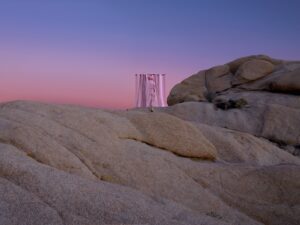Kenji Ouellet’s work is experimental, often sceptical, and deliberately ambiguous. It exposes the viewer to entanglements, questions without simple answers, strange metaphors and contradictions whilst pushing against dominant narratives and ultimately offering a space to reflect. In-keeping with his dual background in musical performance and film, sound and image are of equal importance. Contrapunctus V (5) shows simultaneous events and multi-layered architectural structures. The soundtrack involves quotes about sleep, capitalism, work, the emergence of Artificial Intelligence and the effect of internet usage on the brain. Here, Ouellet tells us about a quote from the Montreal Cognitive Assessment (MoCA), the ways of presenting fragmentation through the senses and the artistic importance of ambiguity and nuance.
A: Voices in Contrapunctus V speak about themes ranging from time to sleep. How did you select these quotes?
KO: There are some I found whilst doing research for this piece and others I simply remembered. For me these quotes crystallise attitudes, ideologies or mechanisms and describe phenomenons, problems or fantasies that I find interesting and about which I wanted to provoke a reflexion. I embedded them together to suggest a relationship between the words. Most quotes don’t last long, in line with the shortening of attention spans mentioned in the soundtrack. There is no text written by me. I wanted to let the viewer/listener connect the dots and let the chosen statements resonate by themselves. Of course, it doesn’t necessarily mean I agree with them. The longest quote is the Montreal Cognitive Assessment (MoCA), a test used to detect cognitive decline and early signs of dementia. Not all quotes involve language, one of them is (as far as I know) the first published pop song generated by Google’s magenta, which was supposedly made without human correction.
A: What is the relationship between the audio and visual in this piece?
KO: The use of simultaneous and multiple layers connects both of these elements but there are a range of relationships between them too. For instance, it is a challenge to grasp all that is being said and shown in just one viewing. This goes back to the Contrapunctus V’s theme of mind fragmentation and it is also a sort of philosophical statement. Although the city images are shot in our “present”, their compositions sometimes seem to suggest the future. The way they are photographed can make our sense of orientation difficult whilst the quotes heard from people living with dementia (and polyphasic sleeping) conveys disorientation in both time and space. There are some sounds that originate within the images, and some, like most of the voices, that are non-diegetic. All of the images were shot at night, resonating with the words that talk about sleeping, dreaming and working.
A: There are instances in the film where it seems like these distinct voices respond to one another. What were your main considerations when it came to sequencing quotes?
KO: Most voices show a progression. For instance, in a few threads, we gradually hear more about forms of human brain decline. In another thread, we hear successful people encouraging their listeners to sleep less. This is followed by a man experimenting with polyphasic sleep, which involves training the body to sleep less by taking short naps instead of resting throughout the night. When this speaker talks about its effect on his dreams, we hear a different voice also talk about Artificial Intelligence (AI) as a dream and the “brain form” that is rising. This rise of AI is thus superposed with a test for brain decline, which in turn can be caused by insufficient sleep. The interplay between voices avoids simplistic question-answer patterns whilst this way of timing and choreographing the audience’s attention is inspired by counterpoint in music, which is a technique where several simultaneous melodies are autonomous but interdependent. Another aspect I want to suggest is micro-sleep and a mind being assailed by different thoughts that sometimes interrupt each other whilst still being related to one attempted train of thought.

A: Could you tell us more about the role of ambiguity in your artistic practice?
KO: I am often interested in questions that don’t have obvious answers. In my work I am less keen on binary debates, even though they can be unavoidable or necessary. I also find that some things don’t need to be explicitly criticised to be put into question. Sometimes it is enough to state them clearly, or show them in a context that adds a question mark to them. The risk is to be misunderstood by some; the reward is that their eventual flaws can make themselves known on their own. That’s what good comedy sometimes does, for instance. Ambiguity is something you will find in koans and riddles, which are all about provoking thinking, as opposed to telling people what to think. Ambiguity and nuance undermine certainties and I personally find that’s one of the interesting functions art can have.
A: What are you most looking forward to at the Aesthetica Art Prize exhibition?
KO: I hope to experience works that will speak to me or touch me in unexpected ways. I also find it useful to learn about the ways viewers or listeners experience my work.
Ouellet will feature in the Aesthetica Art Prize 2024 Exhibition at York Art Gallery from 16 February – 21 April. Meet over 250 longlisted international artists in our new online gallery.
Want to get involved? The next edition of the Prize is open for entries. Submit your work by 31 August. Win £10,000, exhibition and publication. Find out more here.
Image Credits:
- Kenji Ouellet. Still from Contrapunctus V (2022). Single channel digital video, 17 min 51 sec.





